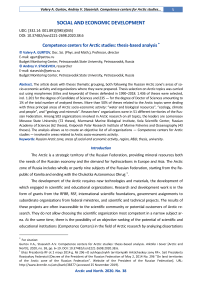Competence centers for Arctic studies: thesis-based analysis
Автор: Gurtov Valery A., Stasevich Andrey V.
Журнал: Arctic and North @arctic-and-north
Рубрика: Social and economic development
Статья в выпуске: 38, 2020 года.
Бесплатный доступ
The article deals with theses thematic grouping, both following the Russian Arctic zone’s areas of socio-economic activity and organizations where they were prepared. Thesis selection on Arctic topics was carried out using morphemes (titles and keywords) of theses defended in 1990-2018. 1.436 of theses were selected, incl. 1.201 for the degree of Candidate of Sciences and 235 - for the degree of Doctor of Sciences amounting to 1% of the total number of analyzed theses. More than 50% of theses related to the Arctic topics were dealing with three principal areas of Arctic socio-economic activity: “water and biological resources”, “ecology, climate and people”, and “geology and minerals”. Researchers’ organizations were located in 51 different territories of the Russian Federation. Among 503 organizations involved in Arctic research on all topics, the leaders are Lomonosov Moscow State University (72 theses), Murmansk Marine Biological Institute, Kola Scientific Center, Russian Academy of Sciences (62 theses), Knipovich Polar Research Institute of Marine Fisheries and Oceanography (43 theses). The analysis allows us to create an objective list of all organizations - Competence centers for Arctic studies - involved in areas related to Arctic socio-economic activity.
Russian arctic zone, areas of social and economic activity, region, r&d, thesis, university
Короткий адрес: https://sciup.org/148318403
IDR: 148318403 | УДК: [332.14: 001.891](985)(045) | DOI: 10.37482/issn2221-2698.2020.38.6
Текст научной статьи Competence centers for Arctic studies: thesis-based analysis
The Arctic is a strategic territory of the Russian Federation, providing mineral resources both the needs of the Russian economy and the demand for hydrocarbons in Europe and Asia. The Arctic zone of Russia includes wholly or partly nine subjects of the Russian Federation, starting from the Republic of Karelia and ending with the Chukotka Autonomous Okrug 1.
The development of the Arctic requires new technologies and materials, the development of which engaged in scientific and educational organizations. Research and development work is in the form of grants from the RFBR, RSF, international scientific foundations, government assignments to subordinate organizations from federal ministries, and scientific and technical projects. The results of these projects are often inaccessible to the scientific community or potential customers of Arctic research. They do not allow choosing the scientific organization most competent in a narrow subject area. At the same time, there is the possibility of an objective ranking of the potential of scientific and educational institutions (Competence Centers) in the field of Arctic research by analyzing dissertations
by full-time employees of these organizations [1, Gurtov V.A., Pakhomov S.I.].
The dissertation represents completed scientific research carried out for 3 – 5 years for candidates and 10 – 15 years for doctoral dissertations, which is an advantage of the above approach to the selection of Competence centers. When preparing a dissertation, an applicant for a scientific degree of Doctor of Sciences publishes an average of 56 scientific articles in scientific journals on the subject of dissertation research, incl. 22 scientific articles in the HAC list journals, and 4 WoS and Scopus publications. An applicant for the degree of Candidate of Science publishes 12 scientific articles, incl. 5 HAC publications, 1 WoS, and Scopus [2, ed. Pakhomov S.I.]. Scientific research in the organization requires annual R&D financing of about 1 million rubles per one scientific employee. Thus, organizations, where dissertations are completed and then defended, are de facto leading research centers in the subject area.
The purpose of this article is to analyze the thematic distribution of dissertation research in the areas of socio-economic activity in the Arctic zone of the Russian Federation, to group dissertation research by organizations where they are prepared, and the formation of Competence Centers on their basis.
Materials and methods
The basis for the analysis was an array of dissertations for the degrees of Candidate and Doctor of Sciences, defended in 1990 – 2018. Review of this array for 1990 – 2000 years was carried out and based on the data of the dissertation fund of the Russian State Library, and for the dissertations 2001 – 2018, it was based on the database of reports of dissertation councils. The analysis included over 300 thousand prints and made it possible to make selections by keywords and the names of dissertations using specific morphemes.
As a result, the number of dissertations for 1990 – 2018 was about 2,500. Of these, 1,436 dissertations were selected by the expert assessment method as the ones belonging to the Arctic theme, incl. 1,101 dissertations for the degree of Candidate of Science and 235 for the degree of Doctor of Sciences, which amounted to 1% of the total number of dissertations analyzed.
Selected dissertations were grouped into nine main sections on areas of socio-economic activity in the Arctic territories:
-
• water and biological resources;
-
• ecology, climate, and people;
-
• geology and minerals;
-
• the medicine;
-
• economics;
-
• oil and gas;
-
• transport infrastructure and construction;
-
• law;
-
• pedagogy.
This sample does not pretend to be entirely complete, but it includes the main Arctic topics and publications devoted to Arctic research in the HAC list journals, as well as WoS and Scopus ones.
A significant part of the publications is related to the study of the Arctic aquatic and biological resources. So, in the article [3, Mozhaev E.E.], the author considers a variety of renewable natural marine resources of the Arctic region of the Russian Federation, directly dependent on the currently changing climate. In the next article [4, Gordeeva N.V., Mishin A.V.], the authors consider specific biological resources of the Arctic and provide data on the genetic variation of the Arctic cod Boreogadus pollack in the Kara, Laptev, and East Siberian seas. Climate change issues on the planet [5, Zolotokrylin A.N., Vinogradova V.V.], the impact of global warming on ecology in the Arctic [7, Matishov G.G., Dzhenyuk S.L.], as well as environmental protection issues in the Russian Arctic [6, Doronina A.K.], are always in the focus of Arctic researchers. Geology and minerals in the Arctic zone are no less popular. So, in the article [8, Pronina N.V., Makarova E.Y.], the authors summarized information on the geological structure of coal-bearing sediments in the Arctic, the quality of coal, the main associated minerals, and particularities of tectonic conditions accompanying the process of the coal formation. The article [9, Bogoyavlenskiy V.I., Bogoyavlenskiy I.V.] represents the analysis of various natural and technological threats to the safety of hydrocarbon development in the Arctic, incl. seismic activity, subsidence of the earth and the seabed, gas deposits in the upper part of the section, and gas emissions from the permafrost zone with the formation of large craters.
Also, medical topics are common in publications on the Arctic. The article [10, Gribanov A.V., Anikina N.Y.] examined the features of the reaction of brain energy processes to cold stress in young people — residents of the Arctic zone of the Russian Federation. It was concluded that in girls, adaptive neurophysiological processes associated with the energy supply to the brain proceed more intensely and require higher energy expenditures than in boys. The article [11, Tereshchenko P.S., Petrov V.N.] studied the incidence of the population beyond the Arctic Circle in comparison with the middle zone of Russia. It was noted that morbidity in the Arctic region is more pronounced for such nosologies as diseases of the eye and adnexa, endocrine, and nervous systems.
Due to the enormous economic potential of the Russian Arctic, which plays a significant role in the development of the country, considerable attention of Russian scientists is paid to various problems of economic growth in the Arctic zone of Russia. The article [12, Mitin A.N., Voronin B.A.] presents a methodology for assessing the resource potential of the Arctic, analyses the main elements of its economy, involved in the food supply of not only the Arctic regions but also the country, as well as in export-import operations. In the article [13, Zamyatina N.Yu., Pilyasov A.N.], the authors set themselves the task of developing a new comprehensive theory of exploration of the North and the Arctic, which would be a synthesis of the best achievements of the Soviet school, foreign studies in the field of innovative development. The article [14, Stepus I.S., Shabaeva S.V.] presents a characteristic of the present and future labor market of the Arctic regions, determined by the list of the most popular professions. It is shown that at present, the demand for professionals is due to the dominance of the extractive industries, development priorities of the regions of the Arctic zone of Russia.
The Russian Arctic is the primary source of oil and gas in our country. Therefore, the prospects for the availability of oil and gas deposits in the Arctic regions [15, Savchenko V.I., Stoupakova A.V.], as well as the problems and limitations that arise during the development of the main bowels of the Arctic [16, Ampilov Yu.P., Zhukov O.V.], are covered in many international and domestic publications. Realization of the oil and gas potential of the Arctic entails the need to develop the transport infrastructure of the Arctic territories [17, Tagiyeva N.K., Onegin V.E.] as a key link in the implementation of Russia's strategic plans to involve substantial natural resources and other economic Arctic resources [18, Golubeva E.A.].
The development of the Arctic territories is impossible without regulatory and legal regulation on the part of the state. The publications [19, Leksin V.N., Porfiriev B.N.] examined the fundamental changes in the organizational, managerial and legal support for the development of the Arctic zone of the Russian Federation in connection with the appearance of a new edition of the state program for the development of the Arctic 2 and the creation of eight key development zones in the Arctic zone of the Russian Federation. The approved innovations required a revision of views on the content of the draft Federal Law on the Development of the Arctic Zone of the Russian Federation 3 in the context of the foreign practice of implementing “Arctic law”, incl. the development of oil and gas resources on the shelf of the Arctic [20, Todorov A.A.]. The implementation of large-scale investment projects envisaged by the development strategy of the Arctic zone of the Russian Federation on the development of the mineral resource base and the development of transport infrastructure (megaprojects), as well as long-term tasks of the socio-economic development of the Russian Arctic [21, Marfusalova V.P., Sa-kerdonova A.S.] is not possible without meeting the needs of enterprises of the Arctic zone of the Russian Federation in labor resources [22, Zaikov K.S., Kondratov N.A.].
The diversity, vast array and different level of publications on Arctic topics do not allow us to unambiguously link the authors of publications and the organizations in which these studies were carried out, to take into account all publications of the organization’s employees on this topic, and thereby rank organizations according to the level of contribution to Arctic research. At the same time, the requirements for dissertation research are the same for applicants of a scientific degree, regardless of the branches of science and organizations. Thus, the organizations based on which full-time employees carry out and then defend their dissertations are the centers of competence for Arctic research.
Research results and discussion
Fig. 1 shows the distribution of 1,466 dissertations for the degrees of Candidate of Science and Doctor of Science on the Arctic zone of the Russian Federation, defended in 1990 — 2018. It follows that the peak of dissertation research by applicants for a scientific degree of Candidate of Science falls on 2004-2007. For applicants of a scientific degree of Doctor of Science, the number of defended dissertations on this topic is approximately constant and is at the level of 8 theses per year.
The distribution of dissertations defended from 1990 to 2018 on the issues related to the Arctic zone of the Russian Federation generally corresponds to the distribution of all dissertations defended in Russia over the same period [23, Gurtov V.A., Shchegoleva L.V.].
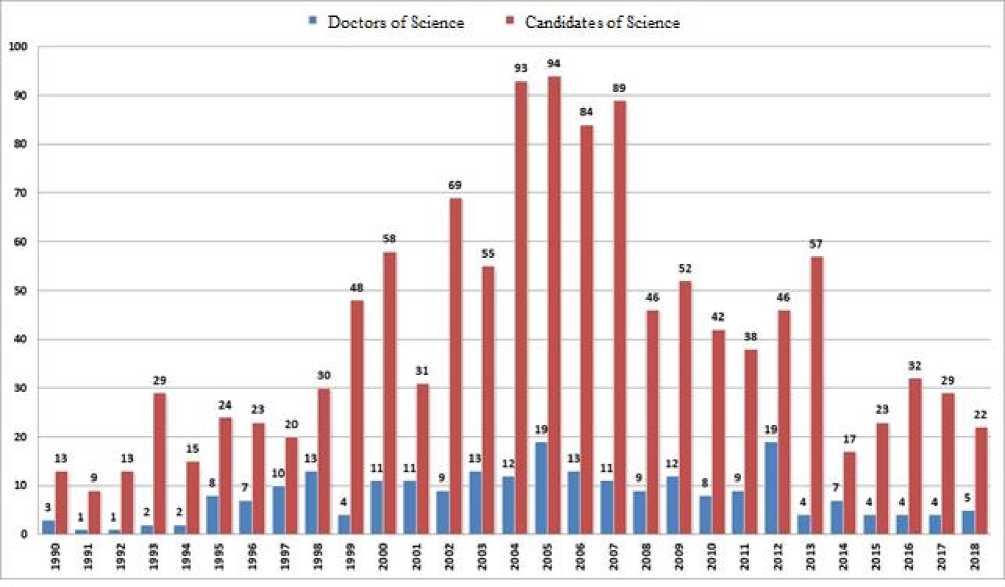
Fig. 1. Distribution of candidate and doctoral dissertations defended in 1990 – 2018 in the AZRF.
In the main thematic areas, dissertation research was distributed as follows: “water and biological resources” — 458 dis., “Ecology, climate and man” — 310 dis., “Geology and minerals” — 274 dis., “Medicine” — 208 dis., “economy” — 201 dis., “oil and gas” — 159 dis., “transport infrastructure and construction” — 117 dis., “law” — 76 dis., “pedagogy” — 74 dis.
At the same time, some of the dissertations are interdisciplinary studies, attributed to several areas of activity.
To identify organizations researching Arctic topics, the place of work of the applicant for a scientific degree at the time of the dissertation defense was considered (since 2011 — the area where the dissertation was completed). The place of work of applicants for a scientific degree (place of a dissertation) was universities — 171, academic institutes — 187 and other organizations — 145. The organizations of the place of work of applicants (places for dissertation) were in 51 different subjects of the Russian Federation (Fig. 2), incl.:
• in Moscow — 133 organizations and 357 theses defended,
-
• in the city of St. Petersburg — 61 organizations and 228 theses defended,
-
• in the Murmansk Oblast — 33 organizations and 225 dissertations defended,
-
• in the Yamalo-Nenets Autonomous Okrug — 31 organizations and 71 dissertations defended,
-
• in the Republic of Sakha (Yakutia) — 30 organizations and 74 dissertations defended.
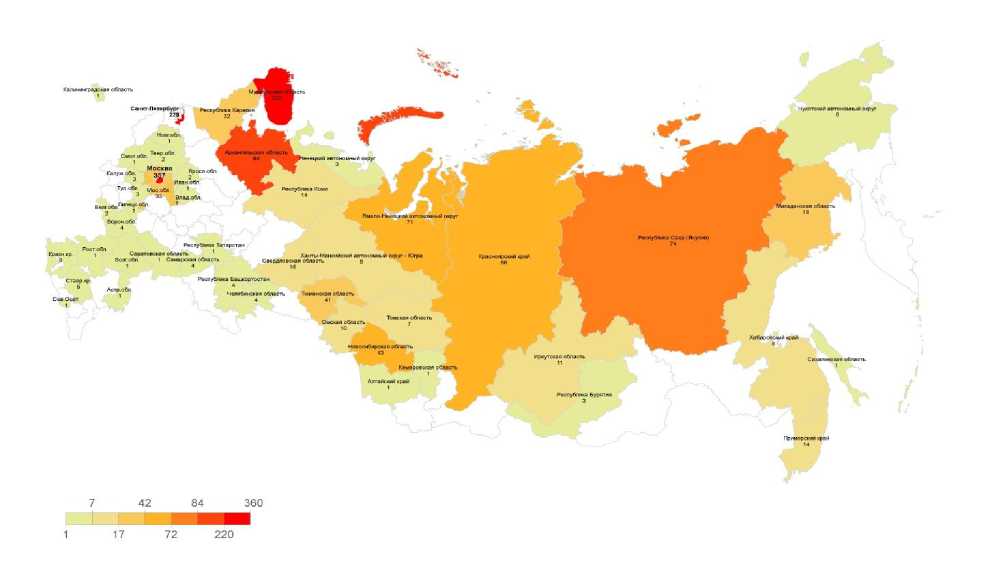
Fig. 2. Distribution of dissertational studies on the Arctic topic in the subjects of Russia.
Among the 503 organizations conducting Arctic research on the main topics, the leaders are Lomonosov Moscow State University, Murmansk Marine Biological Institute of the Kola Scientific Center RAS, Knipovich Polar Research Institute of Marine Fisheries and Oceanography. Table 1 presents a list of the top 10 scientific and educational organizations by the number of dissertations prepared on
Arctic topics.
Table 1
Organizations most active in Arctic research
|
No |
Organization |
Number of dissertations |
|
1 |
Lomonosov Moscow State University |
72 |
|
2 |
Murmansk Marine Biological Institute Kola Science Center RAS |
62 |
|
3 |
Knipovich Polar Research Institute of Marine Fisheries and Oceanography |
43 |
|
4 |
Northern State Medical University |
28 |
|
5 |
Institute of Economic Problems, Kola Science Center RAS |
28 |
|
6 |
Saint Petersburg State University |
27 |
|
7 |
Arctic and Antarctic Research Institute |
26 |
|
8 |
Saint Petersburg Mining University |
26 |
|
9 |
Northern (Arctic) Federal University named after M.V. Lomonosov |
24 |
10 Shirshov Institute of Oceanology of Russian Academy of Sciences 24
Organizations — employers of applicants were in 50 different regions of the Russian Federation. The distribution of the number of dissertations in the main areas of socio-economic activity in the Arctic territories and regions of Russia — the places where the most significant number of studies completed — are presented in Fig. 3.
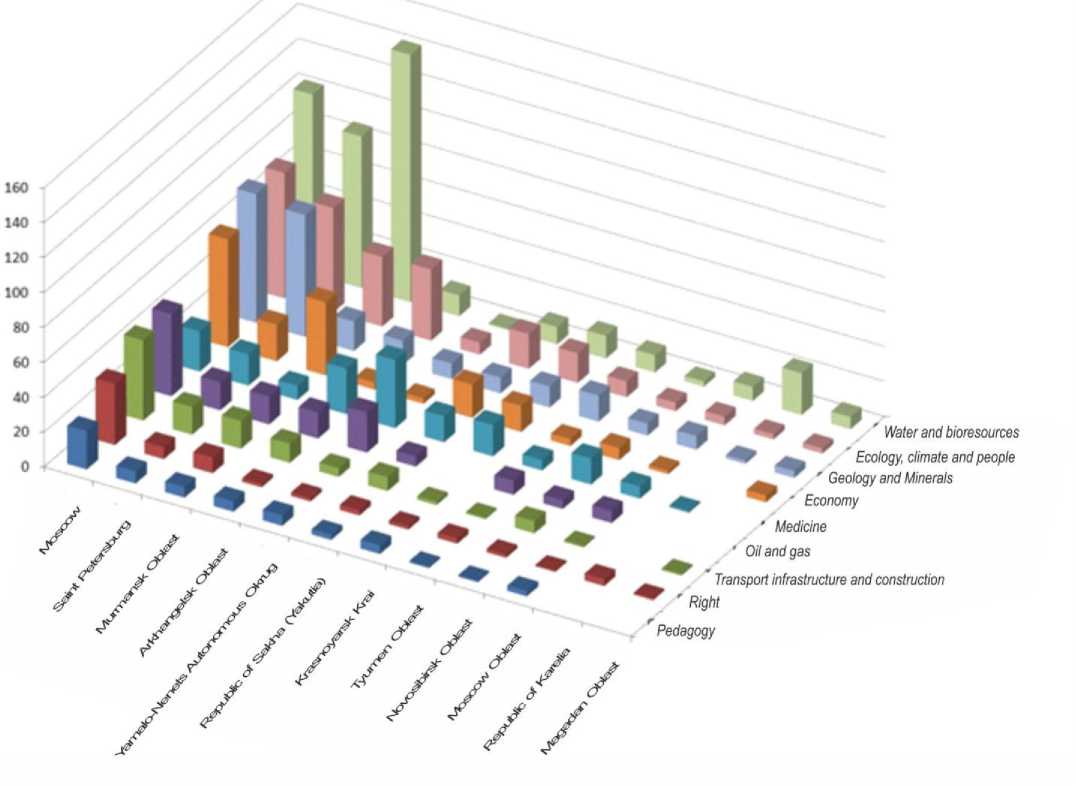
Fig. 3. The distribution of dissertations in the main areas of socio-economic activity in the Arctic territories and subjects of the Russian Federation.
Fig. 3 reveals that in addition to the first five subjects of the Russian Federation, i.e., Moscow, St. Petersburg, the Murmansk Oblast, the Arkhangelsk Oblast, and the Yamalo-Nenets Autonomous Okrug, organizations located in the Republic of Sakha (Yakutia), Krasnoyarsk Krai, Tyumen Oblast, Novosibirsk Oblast, Moscow Oblast, the Republic of Karelia and Magadan Oblast have high dissertation activity.
Table 2 presents a list of the top 20 scientific and educational organizations on the number of dissertations prepared on the Arctic topic in the main areas of socio-economic activity in the Arctic territories. Organizations are sorted in descending order of the total number of dissertations. The color in the table highlights the first three organizations with the maximum number of dissertations in each area of socio-economic activity in the Arctic territories. It should be noted that the Northern (Arctic)
Arctic and North. 2020. No. 38
Federal University named after M.V. Lomonosov is the only educational organization where dissertations were prepared in all nine areas of socio-economic activity in the Arctic territories.
Table 2
Organizations where employees defended the largest number of dissertations on Arctic topics in the main areas of socio-economic activity in the Arctic territories 4
|
No |
Organization |
The number of dissertations on the areas of socio-economic activity in the Arctic territories |
||||||||
|
1 |
2 |
3 |
4 |
5 |
6 |
7 |
8 |
9 |
||
|
1 |
Lomonosov Moscow State University |
40 |
11 |
24 |
1 |
12 |
||||
|
2 |
Murmansk Marine Biological Institute, Kola Science Center RAS |
59 |
12 |
4 |
5 |
2 |
||||
|
3 |
Knipovich Polar Research Institute of Marine Fisheries and Oceanography |
42 |
6 |
1 |
1 |
1 |
||||
|
4 |
Northern State Medical University |
13 |
22 |
1 |
3 |
3 |
1 |
1 |
||
|
5 |
Institute of Economic Problems, Kola Science Center RAS |
2 |
1 |
1 |
26 |
1 |
7 |
2 |
||
|
6 |
Arctic and Antarctic Research Institute |
21 |
13 |
3 |
||||||
|
7 |
FSBI “VNIIOkeangeologia” |
5 |
6 |
19 |
5 |
1 |
||||
|
8 |
Saint Petersburg Mining University |
4 |
6 |
20 |
2 |
2 |
2 |
|||
|
9 |
Saint Petersburg State University |
17 |
6 |
9 |
1 |
1 |
||||
|
10 |
National University of Oil and Gas, “Gubkin University” |
7 |
4 |
1 |
9 |
7 |
2 |
|||
|
11 |
Saint Petersburg State University |
4 |
9 |
2 |
1 |
1 |
6 |
1 |
1 |
5 |
|
12 |
Shirshov Institute of Oceanology RAS |
21 |
3 |
5 |
||||||
|
13 |
Russian Presidential Academy of National Economy and Public Administration (RANEPA) |
2 |
1 |
15 |
2 |
2 |
6 |
|||
|
14 |
Research Institute of Medical Problems of the Far North RAMS |
2 |
23 |
1 |
1 |
|||||
|
15 |
Institute of Ecological Problems of the North, Ural Branch of RAS |
7 |
10 |
8 |
1 |
|||||
-
4 1 — water and biological resources; 2 — ecology, climate, and people; 3 — geology and minerals; 4 — medicine; 5 — economics; 6 — oil and gas; 7 — transport infrastructure and construction; 8 — law; 9 — pedagogy.
16
LLC Nadymgazprom OAO Gazprom
3
4
1
14
4
17
Murmansk State Technical University
11
1
1
6
3
1
1
1
18
North-Eastern Federal University
2
6
3
4
6
2
2
19
Norilsk Industrial Institute
8
5
10
1
20
Petrozavodsk State University
12
3
1
3
More than 1,436 dissertations were defended in 242 specialties of the Nomenclature of specialties of scientists 5. The following groups of scientific specialties are most popular: “25.00.00 Earth sciences” — 363 diss., “03.02.00 General Biology” — 263 diss., and “08.00.00 Economics” — 201 diss.
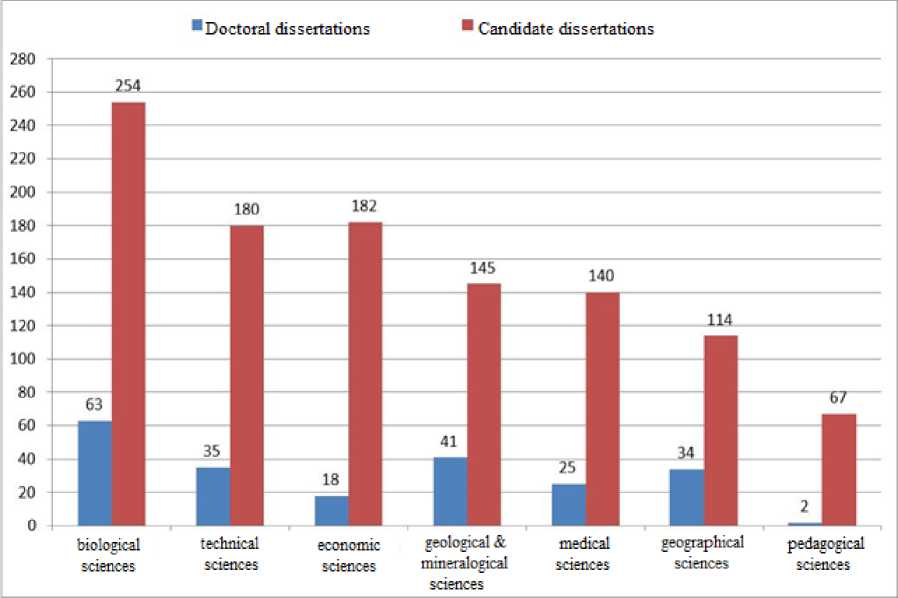
Fig. 4. Distribution of dissertation research on the Arctic zone of the Russian Federation by branches of science.
The distribution of dissertational research on Arctic topics by branches of science shows that most of the dissertations were defended in biological sciences — 254 dissertations for the degree of Candidate of Sciences and 63 for the degree of Doctor of Science.
Conclusion
An analysis of dissertation research on Arctic topics showed that the main Competence centers for Arctic research (90% of theses completed) are in 12 subjects of the Russian Federation, the leaders among which are Moscow, St. Petersburg, the Murmansk Oblast, and the Arkhangelsk Oblast. The leading scientific and educational organizations — Competence Centers in these 12 subjects include 8 academic institutes, 11 universities, and 1 industrial organization. Their employees defended 737 theses in the main areas of socio-economic activity in the Arctic, which is 40 % of the total number of dissertations in arctic subjects.
More than 50% of dissertations related to this theme were prepared in three areas of socio-economic activity in the Arctic territories: “water and biological resources”, “ecology, climate and human”, and “geology and minerals”. 827 dissertations were defended in Arctic subjects — 57% of the total number of dissertations (1436) were defended in three groups of scientific specialties: “25.00.00 Earth Sciences”, “03.02.00 General Biology”, “08.00.00 Economics”.
Список литературы Competence centers for Arctic studies: thesis-based analysis
- Gurtov V.A., Pakhomov S.I. Tematicheskoe i regional'noe raspredelenie nauchnykh issledovaniy Arktiki: analiz na osnove dissertacionnykh rabot [Thematic and regional distribution of scientific research in the Arctic: analysis based on thesis works]. Regionologiya [Russian Journal of Re-gional Studies — Regionology], 2016, no. 4 (97), pp. 94–113.
- Pakhomova S.I., ed. Obzor deyatel'nosti seti dissertacionnykh sovetov v 2018 godu: analitich-eskiy doklad [Review of the activities of the network of dissertation councils in 2018: analytical report]. Petrozavodsk, PetrGU Publ., 2019. 108 p. (In Russ.)
- Mozhaev E.E. Problemy ispol'zovaniya bioresursov Arktiki [The problem of the use of biological resources of the Arctic]. Glavnyy zootekhnik, 2018, no. 4. pp. 39-55. (In Russ.)
- Gordeeva N.V., Mishin A.V. Population Genetic Diversity of Arctic Cod (Boreogadus saida) of Rus-sian Arctic Seas. Journal of ichthyology, 2019, vol. 59, no. 2, pp. 246–254. DOI: 10.1134/S003294 5219020073
- Zolotokrylin A.N., Vinogradova V.V., Sokolov I.A. Climate change and the human life conditions in the Arctic Zone of the Russian Federation. Led i Sneg [Ice and Snow], 2018, vol. 58, no. 2, pp. 243–254. DOI: 10.15356/2076-6734-2018-2-243-254
- Doronina A.K. Voprosy okhrany okruzhayushhey sredy Arktiki pri osushchestvlenii deyatel'nosti v pribrezhnykh moryakh i na kontinental'nom shel'fe [Arctic Environment Protection Issues in Carrying out of Activities in Near-Shore Areas and on the Continental Shelf]. Yuridicheskoe obrazovanie i nauka [Juridical Education and Science], 2018, no. 4, pp. 33–37.
- Matishov G.G., Dzhenyuk S.L., Moiseev D.V. Klimat i bol'shie morskie ekosistemy Arktiki [Cli-mate and large marine ecosystems of the Arctic]. Vestnik Rossijskoj akademii nauk, 2017, vol. 87, no. 2, pp. 110–120. DOI: 10.7868/S0869587317020086
- Pronina N.V., Makarova E.Yu., Bogomolov A.Kh., Mitronov D.V., Kuzevanova E.V. Geology and coal bearing capacity of the Russian arctic in connection with prospects of development of the region. Georesursy [Georesources], 2019, vol. 21, no. 2, pp. 42–52. DOI: 10.18599/grs.2019.2.42-52
- Bogoyavlensky V.I., Bogoyavlensky I.V. Prirodnye i tehnogennye ugrozy pri poiske, razvedke i razrabotke mestorozhdeniy uglevodorodov v Arktike [Natural and technogenic threats in pro-specting, exploration and development of hydrocarbon fields in the Arctic]. Mineral'nye resursy Rossii. Ekonomika i upravlenie [Mineral resources of Russia. Economics and Management], 2018, no. 2, pp. 60–70.
- Gribanov A.V., Anikina N.Yu., Kozhevnikova I.S., Malyavskaya S.I., Pankov M.N. Cerebral ener-gymtabolism reaction to cold stress in young people living in the arctic region. Ekologiya Che-loveka [Human Ecology], 2019, no. 3, pp. 17–23. DOI: 10.33396/1728-0869-2019-3-17-23
- Tereshсhenko P.S., Petrov V.N. Veroyatnaya prichina zabolevaemosti naseleniya prozhivayush-hego v rayonakh Arktiki [Probable cause of morbidity of the population in the areas of the Arc-tic]. Trudy Kol'skogo nauchnogo centra RAN [Proceedingsof the Kola Science Center of the Rus-sian Academy of Sciences], 2018, vol. 9, no. 2–13, pp. 145–150. DOI: 10.25702/KSC.2307-5252.2018.9.2.145-150
- Mitin A.N., Voronin B.A., Donnik I.M. Economic and Legal Mechanisms for Harnessing Natural Re-source Potential of the Arctic in the Context of Food and Environmental Security. Economy of Region, 2018, vol. 14, no. 2, pp. 408–419. DOI: 10.17059/2018-2-6
- Zamyatina N.Yu., Pilyasov A.N. Novaya teoriya osvoeniya (prostranstva) Arktiki i Severa: poli-masshtabnyy mezhdisciplinarnyy sintez [The new theory of the Arctic and northern develop-ment: multi-scale interdisciplinary synthesis]. Arktika i Sever [Arctic and North], 2018, no. 31, pp. 5–27. DOI: 10.17238/issn2221-2698.2018.31.5
- Stepus I.S., Shabaeva S.V. Nastoyashchee i budushchee rynka truda regionov Arkticheskoy zony Rossii: vostrebovannye professii [Present and future of the Russian arctic zone regions labour market: occupations in demand]. Nepreryvnoe obrazovanie: XXI vek [Lifelong learning: 21st cen-tury], 2019, no. 3 (27), pp. 98–111.
- Savchenko V.I., Stoupakova A.V., Peretolchin K.A. The prospects of large oil and gas fields in the Eastern Taimyr. Georesursy [Georesources], 2017, special issue, part 2, pp. 186–193. DOI: 10.18599/grs.19.19
- Ampilov Yu.P., Zhukov O.V. Osvoenie nedr Arktiki: ot nefti i gaza k poleznym iskopaemym dlya novogo tekhnologicheskogo uklada [Development of the Arctic bowels: from oil and gas to min-erals for a new technological mode]. Regional'naya energetika i energosberezhenie [Regional Energy and Energy Saving], 2018, no. 1, p. 42.
- Tagieva N.K., Onegin V.E. Doroga v Arktiku: strategiya razvitiya i transportnaya infrastruktura [The road to the Arctic development strategy and transport infrastructure]. Delovoy zhurnal Neftegaz.RU [Business magazine “Neftegaz.RU”], 2018, no. 5, pp. 58–61.
- Golubeva E.A. Perspektivy razvitiya transportnoy infrastruktury Arktiki [Prospects for the devel-opment of transport infrastructure in the Arctic]. Istoriya i perspektivy razvitiya transporta na severe Rossii [History and prospects for the development of transport in the north of Russia], 2017, no. 1, pp. 134–138.
- Leksin V.N., Porfiriev B.N. Russian Arctic today: Substantive novelties and legal collisions. Econ-omy of Region, 2018, vol. 14, no. 4, pp. 1117–1130. DOI: 10.17059/2018-4-5
- Todorov A.A. Podkhody zarubezhnykh stran k pravovomu regulirovaniyu razrabotki nefte-gazovyh resursov na shel'fe Arktiki [Approaches of foreign countries to the legal regulation of the oil and gas development on the Arctic continental shelf]. Arktika i Sever [Arctic and North], 2018, no. 30, pp. 40–59. DOI: 10.17238/issn2221-2698.2018.30.40
- Marfusalova V.P., Sakerdonova A.S. Znachenie institutov obrazovaniya v sokhranenii i razvitii yazykov i kul'tury korennyh narodov Arktiki [The Role of Educational Institutions in Preservation and Development of Languages and Cultures of Indigenous Peoples of the Arctic]. Vestnik severo-vostochnogo federal'nogo universiteta im. M.K. Ammosova. Seriya: Pedagogika. Psikhologiya. Filosofiya [Vestnik of North-Eastern Federal University. Series: Pedagogics. Psy-chology. Philosophy], 2017, no. 1 (05), pp. 38–43.
- Zaikov K.S., Kondratov N.A., Kudryashova E.V., Tamitskiy A.M. Potrebnost' sub’’ektov Arktich-eskoy zony RF v trudovykh resursakh [The Need for Workforce in Constituent Entities of the Arctic Zone of the Russian Federation]. Ekonomicheskie i sotsial'nye peremeny: fakty, tendentsii, prognoz [Economic and social changes: facts, trends, forecast], 2018, vol. 11, no. 6, pp. 184–201. DOI: 10.15838/esc.2018.6.60.11
- Gurtov V.A., Shchegoleva L.V., Pakhomov S.I. Prognoznaya otsenka chislennosti doktorov i kan-didatov nauk v Rossii [Forecast of the Number of Doctorate Holders in Russia]. Inzhenernye tehnologii i sistemy [Engineering Technologies and Systems], 2019, vol. 29, no. 4, pp. 510–528. DOI: https://doi.org/10.15507/2658-4123.029.201904.510-528

